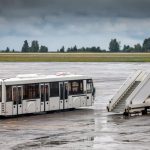 Last year I visited Heathrow airport’s applied innovation facility to try out an autonomous shuttle demonstration provided by French company Navya. The shuttle was restricted to the car park at the facility and travelled at walking pace, but it showed a degree of intent nonetheless.
Last year I visited Heathrow airport’s applied innovation facility to try out an autonomous shuttle demonstration provided by French company Navya. The shuttle was restricted to the car park at the facility and travelled at walking pace, but it showed a degree of intent nonetheless.
Rival London airport Gatwick might steal a march however and introduce autonomous shuttle transportation before their larger peer. The airport has announced a trial of autonomous vehicles provided by leading startup Oxbotica. The vehicles will shuttle workers between popular locations at the airport later this summer.
The project aims to prove the value of the technology in a live environment, with the ultimate hope of replacing existing fleets of vehicles with autonomous shuttles. Indeed, the team even believe that it could be the first step on the road to wider automation of everything from baggage tugs to passenger load bridges. The trade body for the world’s airlines, the IATA, believe there could ultimately be over 40 use cases for autonomous technologies in airports.
Baby steps
Suffice to say, the technology is still some way from that ultimate vision, and this initial trial will not involve any members of the public, or indeed be run on any public roads.
The project will hopefully generate enough data to showcase the potential of the technology on a live and active airfield, which has a degree more complexity than the public roads many autonomous technologies have been tested on.
The data generated from the pilot will be shared with the Department of Transport and Civil Aviation Authority, whilst the likes of insurance company XL Catlin have also expressed an interest in it to understand the insurance implications of the application of driverless technology in airport environs.
“If this trial proves successful then in the future we could have an Uber-like service operating across the airfield which staff can hail as and when they need to travel,” Gatwick say. “This trial is just the start and much more research will be needed, but ultimately this could be the start of widespread use of autonomous vehicles on airfields across the world. The new technology is a more efficient way to manage vehicles and could lead to a reduction in the number of vehicles required, their associated costs and harmful emissions.”
Autonomous baggage handlers have, of course, already been tested. In 2016, Geneva airport tested a device, called Leo, which was capable of greeting a passenger as they enter the terminal and then taking care of their luggage for them. First they weigh each bag, before then printing off the relevant tag, checking the bags in and carrying them to the baggage handling area.
Leo was capable of navigating the airport by itself, avoiding not only the physical aspects of the building but also the passengers. The aim was to significantly speed up the check-in process.
Robots were also present at the South Korean winter Olympics, providing a range of support and translation services to visitors. It’s still very early days in the transformation of air travel, but it is nonetheless one of the more interesting domains to monitor.